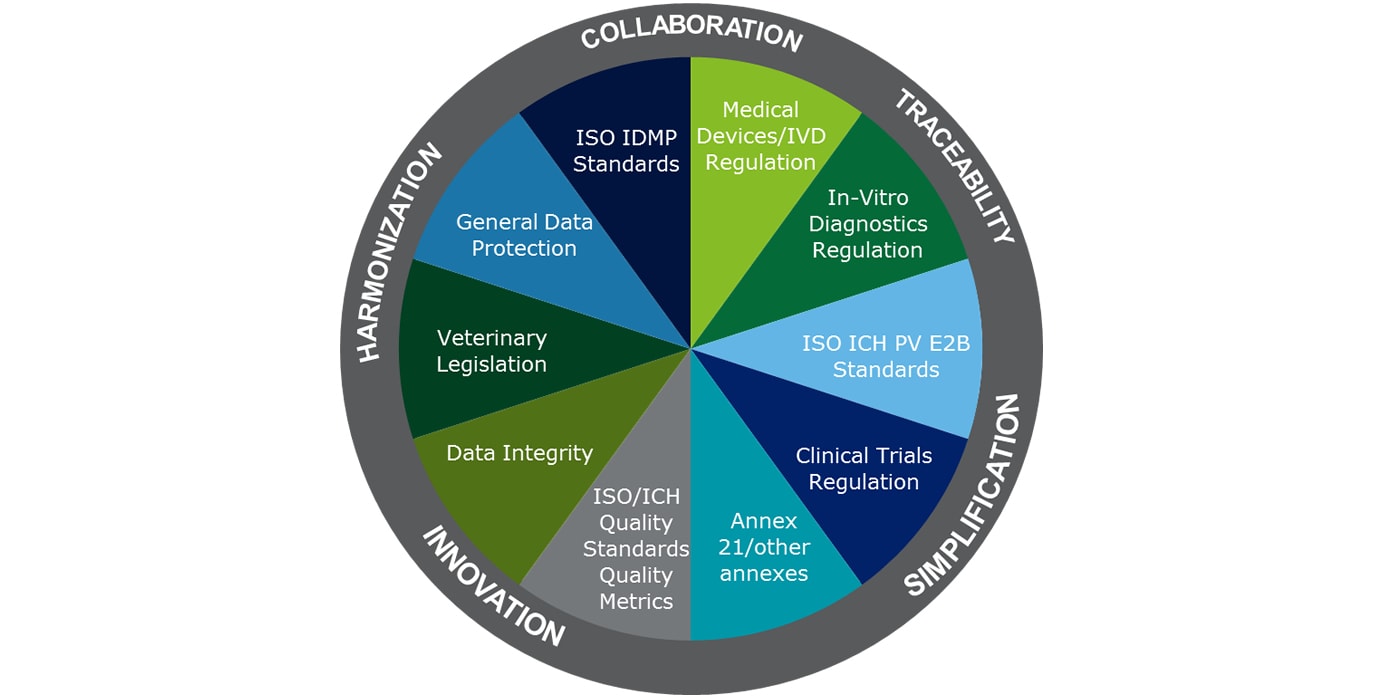Insight

The bigger picture
Impact of EU regulatory change on the global life sciences industry
Recent and ongoing European regulatory changes will impact every pharmaceutical, biotechnology or medical technology (medtech) company that currently sells or sponsors products in the European Union (EU). Companies can be well-equipped by taking a proactive approach to tracking and monitoring the regulatory developments and understanding their independent and combined impact on the business.
Overview of EU regulatory changes

Identification of Medicinal Products (IDMP) Data Standards
The IDMP data standards are being developed and implemented by the International Organization for Standardization (ISO), regulators, trade associations and other stakeholders in response to a worldwide demand for internationally harmonized specifications for medicinal products. Under the IDMP standards, pharmaceutical companies will be required to electronically submit detailed product data and maintain it on an ongoing basis.
Medical Devices Regulation
The Medical Devices Regulation aims to safeguard prompt and timely access to innovative devices for both patients and medical professionals, improve coordination between EU member states, and re-establish public confidence. Manufacturers will need to carefully consider the impact and the financial implications of the new and more stringent requirements for medical devices and plan early for a transition to the new regulation.
Clinical Trials Regulation
The Clinical Trials Regulation mandates that the EMA has to deliver, update, and maintain a number of IT platforms and systems to improve how clinical trials are applied for, assessed, and monitored in the EU. Over the last few years, increasing numbers of life sciences companies have adopted a more open and transparent policy for their clinical trial outcomes, irrespective of whether the results are positive or negative. Companies will need to prepare and conduct training on new SOPs, adapt clinical trial application processes, implement a suitable system for notifications, and monitor member state-level implementation.
Enhanced EudraVigilance System
The updated EU pharmacovigilance legislation requires the EMA to enhance EudraVigilance to deliver simplified reporting, better quality data and improved searching, analysis, and tracking functionalities, and move to the new ISO International Conference on Harmonization (ICH) individual case safety report (ICSR) standard (27953-2:2011). Implementing the new ICSR standards will require significant efforts including system upgrade, business process review and providing training to the database users.
Falsified Medicines Directive
The serious health threat posed by falsified medicines led to the EU adopting Directive 2011/62/EU, which is often referred to as the Falsified Medicines Directive, or FMD. Under FMD, all pharma manufacturers, parallel traders, re-packagers and contract manufacturers will have to make sure they have adapted their packaging lines and systems to comply with the delegated act by the deadline. They will also need to manage and exchange the highly complex set of product information and serialization data with their supply chain business partners.
ICH Q12
ICH Q12 aims to fill the gap in the ICH quality guidelines Q8-Q11 by allowing more productive and efficient management of Chemistry, Manufacturing and Controls (CMC) post-approval changes while promoting continual improvement, strengthening quality, and facilitating reliable product supply. Companies will need to plan to implement global dossiers with defined design parameters, prepare for global alignment, and implement a repository.
Annex 21-Importation of Medicinal Products
The new Annex 21 to the EU GMP guidelines aim to address medicinal products which are manufactured in countries outside the EU supply chains and imported into the EU, and the issue of multiple licenses being required if various sites are involved. Companies will need to assess whether more than one license might be needed, if various manufacturing sites are involved in producing a drug, and check the definition of “an importer” after the guidance is finalized.
Manufacturing Quality Metrics
The Quality Metrics Technical Conformance Guide outlines the recommended data the industry should submit to the FDA and clarifies FDA expectations for the quality of the metrics required. Companies will need to review and align internal processes and IT systems, estimate costs required for adjusting IT systems, and assess and prepare for optional metrics.
Veterinary Product Proposals
The new legislation is designed to increase the availability of veterinary medicinal products (VMPs) throughout the EU while reducing administrative burden. It also will address the risk of antimicrobial resistance (AMR) by managing the availability of antimicrobials for use in animals. Companies will need to identify the potential for collaboration within the industry, assess the VMP proposals’ impact on ISO IDMP standards, and adhere to new requirements to integrate eSubmission data into the product database (MAHs).
What should life sciences companies be doing now?
The EU life sciences regulatory landscape is evolving quickly and irrevocably. It is important, therefore, that companies track and monitor legislative and industry developments, as the changing environment holds significant license-to-operate implications for pharmaceutical and medical device companies that supply products to the EU. Although timelines continue to fluctuate, manufacturers, distributors, providers, and other stakeholders should evaluate the individual and collective impacts of new regulations and take a proactive approach to managing regulatory change.